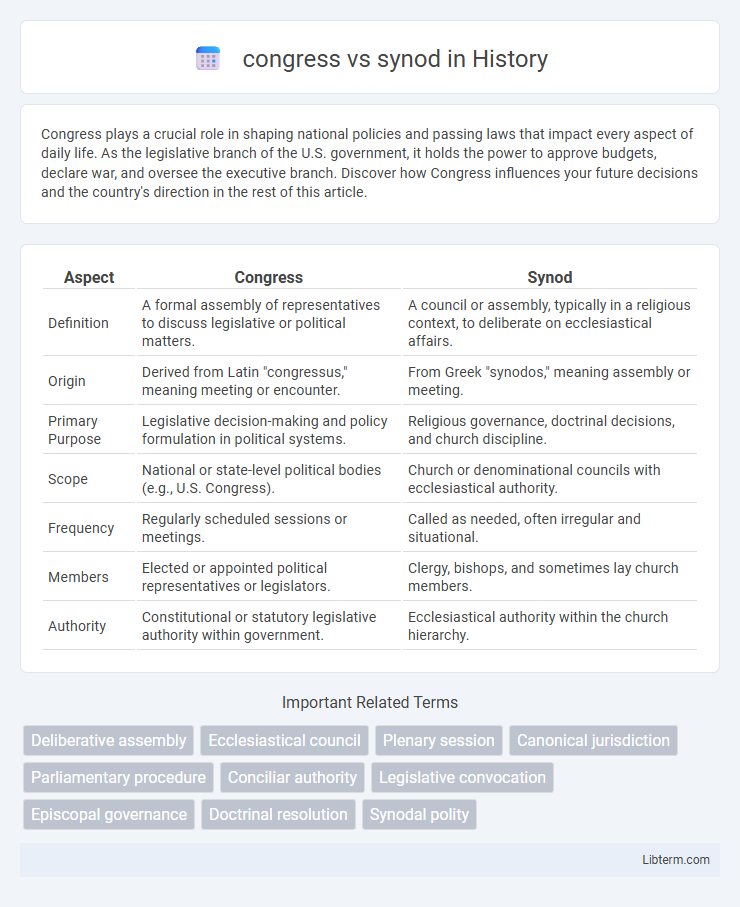Congress plays a crucial role in shaping national policies and passing laws that impact every aspect of daily life. As the legislative branch of the U.S. government, it holds the power to approve budgets, declare war, and oversee the executive branch. Discover how Congress influences your future decisions and the country's direction in the rest of this article.
Table of Comparison
| Aspect | Congress | Synod |
|---|---|---|
| Definition | A formal assembly of representatives to discuss legislative or political matters. | A council or assembly, typically in a religious context, to deliberate on ecclesiastical affairs. |
| Origin | Derived from Latin "congressus," meaning meeting or encounter. | From Greek "synodos," meaning assembly or meeting. |
| Primary Purpose | Legislative decision-making and policy formulation in political systems. | Religious governance, doctrinal decisions, and church discipline. |
| Scope | National or state-level political bodies (e.g., U.S. Congress). | Church or denominational councils with ecclesiastical authority. |
| Frequency | Regularly scheduled sessions or meetings. | Called as needed, often irregular and situational. |
| Members | Elected or appointed political representatives or legislators. | Clergy, bishops, and sometimes lay church members. |
| Authority | Constitutional or statutory legislative authority within government. | Ecclesiastical authority within the church hierarchy. |
Definition of Congress and Synod
A congress is a formal gathering of representatives from various groups or organizations, often convened to discuss and make decisions on political, social, or professional matters. A synod specifically refers to an assembly of church officials or clergy, primarily in Christian traditions, convened to deliberate on ecclesiastical policies, doctrines, and governance. Both terms denote organized meetings but differ in scope and purpose, with congresses typically secular and synods religious.
Historical Origins and Development
Congresses originated as secular, political gatherings aimed at legislative decision-making, tracing back to early modern European parliamentary assemblies in the 16th century. Synods emerged from ancient ecclesiastical councils within the Christian Church, dating back to the 4th century, primarily focused on doctrinal and organizational issues. Over time, congresses evolved into formal governmental institutions, while synods maintained their role as authoritative church deliberative bodies shaping religious doctrine and practice.
Structural Differences Between Congress and Synod
A congress is typically a large formal assembly representing various constituent groups with broad legislative or policy-making powers, whereas a synod is a church-based council primarily focused on ecclesiastical governance and doctrinal issues. Structural differences include the scope of authority, with congresses functioning as sovereign legislative bodies often comprising multiple chambers, while synods are ecclesiastical bodies composed of clergy and laity organized in hierarchical or regional groupings. Congresses convene as part of governmental frameworks and operate under constitutional mandates, whereas synods function within religious denominations, emphasizing spiritual oversight and church governance.
Purpose and Functions of a Congress
A congress serves as a formal assembly designed to deliberate on legislative matters, establish policies, and elect representatives or officers within political or organizational frameworks. Its primary functions include debating proposed laws, shaping strategic directions, and fostering collaboration among diverse stakeholders to reflect collective interests. Unlike a synod, which typically focuses on ecclesiastical governance and doctrinal issues, a congress emphasizes political decision-making and legislative authority.
Role and Objectives of a Synod
A synod functions as a council of church officials convened to deliberate on doctrinal issues, liturgical practices, and administrative policies within a specific Christian denomination. Its primary role involves fostering ecclesiastical unity, guiding theological direction, and addressing pastoral concerns to ensure alignment with the church's mission and teachings. Synods aim to facilitate collaborative decision-making among clergy and laity, reinforcing church governance and promoting spiritual growth within the faith community.
Decision-Making Processes Compared
Congress and synods differ significantly in decision-making processes, with congresses typically involving broad representation from diverse stakeholders who vote on legislation or policy, allowing for majority rule decisions. Synods, especially within religious contexts, emphasize consensus-building among clergy and laity leaders, often guided by doctrinal considerations and hierarchical authority to ensure unity and adherence to faith principles. The structured debate and voting in congresses contrast with the deliberative, spiritually-oriented discussions in synods, reflecting their distinct organizational goals and cultural frameworks.
Membership and Representation
A congress typically features broad membership that includes all qualified participants, allowing direct representation from individual members, organizations, or interest groups. A synod, conversely, consists primarily of elected delegates or representatives chosen by regional or local bodies, emphasizing hierarchical or ecclesiastical authority structures. Membership in a congress is usually open and comprehensive, whereas synod representation is limited and structured around formal ecclesiastical or organizational criteria.
Key Examples: Congresses and Synods in Practice
Congress and synod both serve as assemblies for decision-making but differ in scope and authority; for instance, the U.S. Congress legislates federal laws, while a church synod governs ecclesiastical matters within a denomination. The Second Vatican Council is a key example of a synod impacting global Catholic doctrine, whereas the Indian National Congress played a pivotal role in India's independence movement through political deliberation. These examples illustrate congresses' focus on political governance against synods' emphasis on religious and doctrinal authority.
Influence on Policy and Doctrine
Congress shapes policy through legislative authority, passing laws that influence both civil governance and religious institutions indirectly. Synods hold significant power in defining doctrinal positions and internal church regulations, directly impacting theological teachings and ecclesiastical practices. The interaction between congress and synod often determines the balance between secular legislation and religious doctrine within a society.
Contemporary Relevance and Challenges
Congress and synods differ in their contemporary roles, with congresses typically addressing broader political and social issues, while synods focus on ecclesiastical governance and doctrinal matters. Modern challenges for congresses include managing diverse political interests and ensuring effective representation, whereas synods face difficulties related to adapting religious traditions to evolving cultural contexts and maintaining unity among believers. Both institutions must navigate complex interactions between tradition and modernity to remain relevant in today's rapidly changing societal landscape.
congress Infographic

 libterm.com
libterm.com